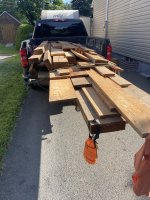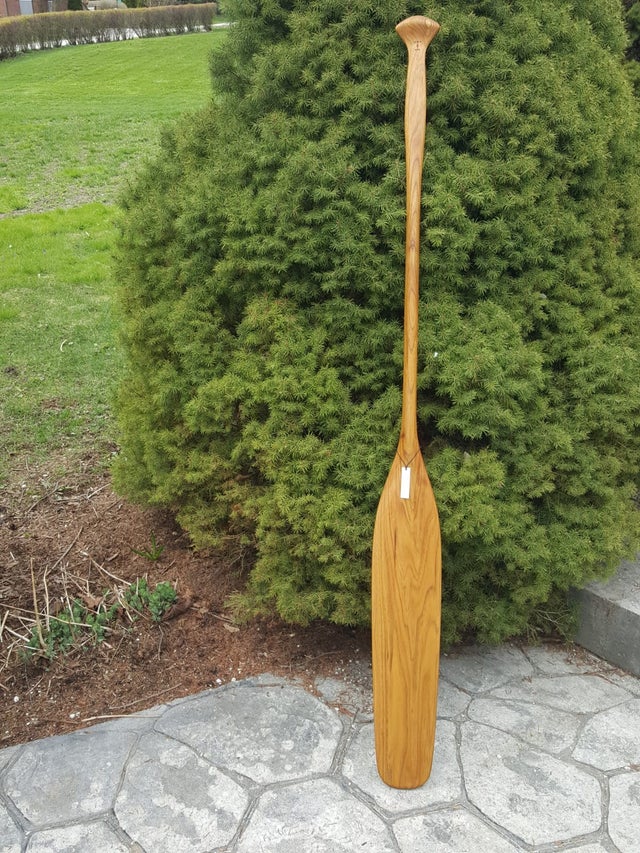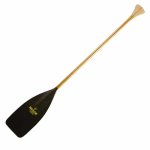Being seduced in my dotage by certain possible hydrodynamic advantages of the ottertail blade shape for canoe cruising, but never having owned one amongst my dozens of paddles, I embarked on a quest in April to find the best custom paddle maker in North America.
With some candidates in mind, I learned that the first challenge was to actually get in touch with one of these small or one man shops. Or, if I could get in touch, to get any sort of firm commitment on a manufacture and ship date. Some of these folks had an annoying habit of being unavailable because they had the temerity to simply disappear . . . to . . . go . . . canoeing! How dare they!?
I finally settled on the fully hand-crafted paddles of the venerable Bruce Smith, who has been making custom paddles and wood-canvas canoes in the Fergus, Ontario, area since the 1970's, having been taught by the legendary Walter Walker, whose canoes can still fetch prices of over $20,000. Bruce's paddles feature his trademark version of a secondary grip, sometimes called a "running pry grip" in Canada or a "northwoods" or "guide" grip in Maine.
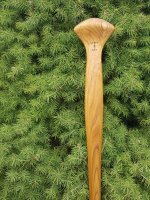
I didn't want a heavy and especially a blade heavy animal tail "club", as some of my beavertails are, and had many emails and a phone call with Bruce about a lightweight wood choice with optimal shaft-blade balance. We settled on butternut, which is an increasingly rare wood in Canada because of a fungus killing live butternut trees en masse and powder puff beetles boring holes in the dead trees. But Bruce did have a nice butternut board for a 58" paddle with a pronounced plain sawn grain pattern, shown here next to a 57" blem butternut paddle:
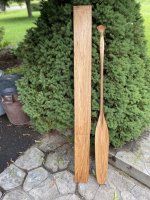
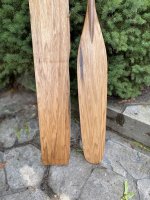
Because Butternut has a fairly low Janka hardness and modulus of rupture -- i.e., is somewhat soft, breakable and subject to denting -- Bruce recommended laminating the shaft with a cousin wood, edge grain black walnut, to increase shaft strength and reduce denting, as used in the blem paddle shown above. I liked this idea for aesthetic reasons also, and further requested a matching black walnut inlay in the top grip.
Having settled all that over three months, Bruce of course went . . . canoeing.
However, he did make 21 custom paddles in August and just sent a picture of them all. Naturally, I already think mine is the most aesthetic. (Can you spot it?)
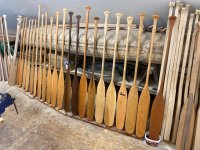
Here is Bruce's description of what is going on with the paddle in the small bucket on the extreme right:
"If you look closely, you will see that I am soaking the tip of my black cherry modified Ottertail on the right. I am using about 80% boiled linseed oil mixed with 20% varsol or mineral spirits. The latter helps the oil penetrate better....deep into the cells. This routine about every 3 years for 4 or 5 days gives you a permanent water seal in the wood fibre at the tip. This keeps water out and prevents the wet/dry or expansion/contraction cycle that often leads to cracks at the tip. An old timer taught me this when I worked at the Ontario Camp Leadership in 1972.......been using this trick ever since."
"I have 4 soaker coats on today with about 50% varsol, 2 more tomorrow and one a day until Sunday. The walnut and butternut ones along with the maple ones will be given 4 coats of spar varnish."
So, I am now awaiting some sort of shipment and figuring out how to pay for it, but naturally Bruce also reports: "I will be leaving for Temagami next Tuesday evening so I would like to get them out on Monday or Tuesday at the latest." Oy vey!
When I finally get my long-awaited paddle, hopefully for some fall paddling, I'll take some close-up photos and report on the actual hydrodynamics.
You can watch video bio of Bruce Smith and his paddle making shop on this page:
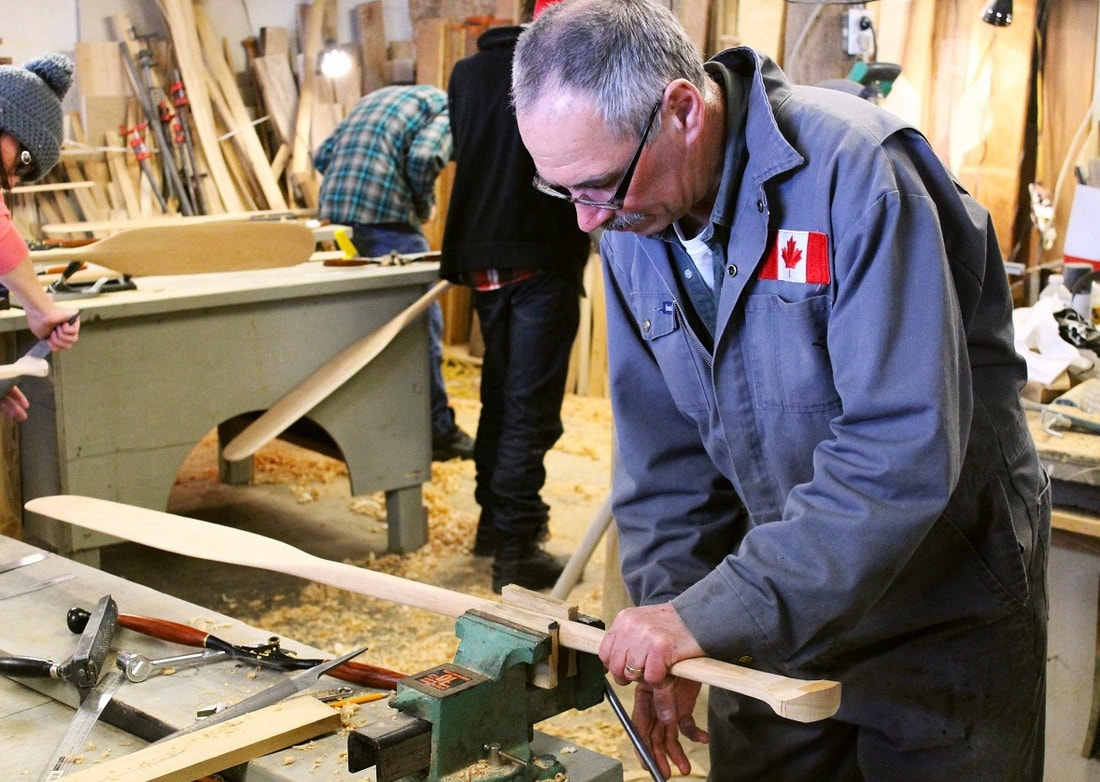
With some candidates in mind, I learned that the first challenge was to actually get in touch with one of these small or one man shops. Or, if I could get in touch, to get any sort of firm commitment on a manufacture and ship date. Some of these folks had an annoying habit of being unavailable because they had the temerity to simply disappear . . . to . . . go . . . canoeing! How dare they!?
I finally settled on the fully hand-crafted paddles of the venerable Bruce Smith, who has been making custom paddles and wood-canvas canoes in the Fergus, Ontario, area since the 1970's, having been taught by the legendary Walter Walker, whose canoes can still fetch prices of over $20,000. Bruce's paddles feature his trademark version of a secondary grip, sometimes called a "running pry grip" in Canada or a "northwoods" or "guide" grip in Maine.

I didn't want a heavy and especially a blade heavy animal tail "club", as some of my beavertails are, and had many emails and a phone call with Bruce about a lightweight wood choice with optimal shaft-blade balance. We settled on butternut, which is an increasingly rare wood in Canada because of a fungus killing live butternut trees en masse and powder puff beetles boring holes in the dead trees. But Bruce did have a nice butternut board for a 58" paddle with a pronounced plain sawn grain pattern, shown here next to a 57" blem butternut paddle:


Because Butternut has a fairly low Janka hardness and modulus of rupture -- i.e., is somewhat soft, breakable and subject to denting -- Bruce recommended laminating the shaft with a cousin wood, edge grain black walnut, to increase shaft strength and reduce denting, as used in the blem paddle shown above. I liked this idea for aesthetic reasons also, and further requested a matching black walnut inlay in the top grip.
Having settled all that over three months, Bruce of course went . . . canoeing.
However, he did make 21 custom paddles in August and just sent a picture of them all. Naturally, I already think mine is the most aesthetic. (Can you spot it?)

Here is Bruce's description of what is going on with the paddle in the small bucket on the extreme right:
"If you look closely, you will see that I am soaking the tip of my black cherry modified Ottertail on the right. I am using about 80% boiled linseed oil mixed with 20% varsol or mineral spirits. The latter helps the oil penetrate better....deep into the cells. This routine about every 3 years for 4 or 5 days gives you a permanent water seal in the wood fibre at the tip. This keeps water out and prevents the wet/dry or expansion/contraction cycle that often leads to cracks at the tip. An old timer taught me this when I worked at the Ontario Camp Leadership in 1972.......been using this trick ever since."
"I have 4 soaker coats on today with about 50% varsol, 2 more tomorrow and one a day until Sunday. The walnut and butternut ones along with the maple ones will be given 4 coats of spar varnish."
So, I am now awaiting some sort of shipment and figuring out how to pay for it, but naturally Bruce also reports: "I will be leaving for Temagami next Tuesday evening so I would like to get them out on Monday or Tuesday at the latest." Oy vey!
When I finally get my long-awaited paddle, hopefully for some fall paddling, I'll take some close-up photos and report on the actual hydrodynamics.
You can watch video bio of Bruce Smith and his paddle making shop on this page:

Bruce Smith Paddles Bio
Bruce Smith had over 50 years experience as a master level canoeist and expert wood worker. He now teaches paddle making workshops and sells his paddle creations in Fergus, Ontario
www.brucesmithpaddles.com


